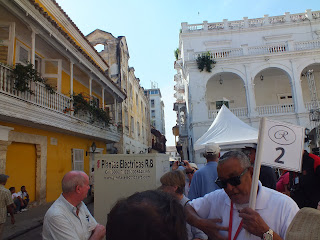The second morning we were in Cartagena Linda and I went in separate directions to explore the city. I headed for the historic part of the city and the fortress.
 |
| View from our balcony while we had breakfast. |
|
|
|
Cartagena, being the major port on the Atlantic and on the South American coast was the target for lots of things, but particularly pirates and governments wanting to conquer it.
 |
| One of the entrances into the fortress tunnels. |
So the residents and the local government built a huge fortress to safeguard the port in the 1500s. It had everything that was needed to support troops and safeguard the community. From cannons to water supplies, ammo to food stores, tunnels built under the fortress were stockpiled. Now tours to visitors lead you deep underground and through dark tunnels to wind in and out of the fortress.
 |
| The tunnels are not very high. There are alcoves where soldiers hid to ambush invaders. |
 |
| From the top of the fortress. |
There is a huge amount of history here that I know nothing about. Cartagena was a slave port, a resupply for square riggers crossing the Atlantic, a place for explorers and conquerors to come to. The citizens here are a beautiful race; a combination of the tribes conquered by the Spaniards, the African slaves brought to the country in chains, and the white Europeans who invaded in the 1500s. Americans know so little of history and how we came to be what we are now.
 |
| Views of the fortress. | |
|
 |
| Views of modern Cartagena from the top of the fortress. |
The modern Cartagena is a multinational city with millions of residents and a thriving population. Being almost on the equator gives the city a temperate climate year round. It's also below the hurricane tracks so it's outside the threat of dangerous weather.
 |
| Historic Cartagena |
The Catholic faith was introduced to the native population when the Spaniards arrived in the 1500s. There are hundreds of churches scattered through Cartagena built with local stone, imported woods and marble. Murals and tapestry tells the story of how the Catholic church made inroads into the local religion.
 |
| Wood altars in one of the larger churches in old Cartagena |
 |
| San Pedro Claver church museum |
One of the revered Catholic priests during the years that the slave trade flourished was San Pedro Claver. He ministered to the slaves being forcibly removed from Africa and then sent to North America. He was proclaimed a Saint after his death. His church and museum is a beautiful tribute to a man who spent his life in service to others.
 |
| The bones of Saint San Pedro are entombed within the alter at the church that bears his name. |
|
 |
| The entrance into the botanical garden. |
|
|
|
|
|
|
Saint San Pedro had a huge botanical garden that he used to make medicine for slaves. His experiments into plants, herbs, leaves and flowers as a basis for medicine is still renowned. His garden is still maintained, along with the well that provided water to so many.
 |
| Native costumes |
 |
| Anna with a lady in native costume. |


















No comments:
Post a Comment